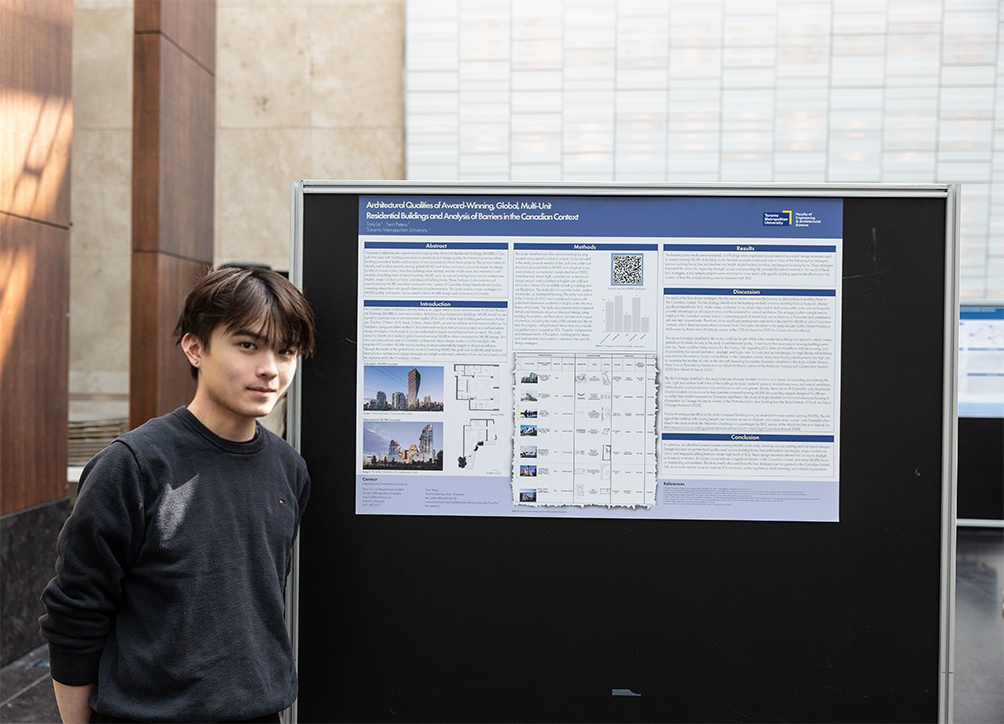Undergraduate Student Tony Le Wins Award for Research on High-Quality Multi-Unit Residential Buildings

Image of Tony Le and his poster at the FEAS Grad Ambassadors Poster Competition
The unique and collaborative research environment at the Department of Architectural Science has enabled third year undergraduate student Tony Le to conduct in-depth research on award-winning global Multi-Unit Residential Buildings (MURBs) and analyze their compatibility with Canadian standards. Tony earned (PDF file) Best Poster Presentation (Undergraduate) at the FEAS Grad Ambassadors Poster Competition on March 21, 2024, and is set to present his co-authored work at the New Horizons in Green Civil Engineering (NHICE) conference in Victoria this summer with funding from the Architectural Science Student Society arc.soc (external link) !
The research project, supervised by DAS Associate Professor Dr. Terri Peters, along with collaboration from Marianne Touchie and Liam O'Brien from the Department of Civil and Mineral Engineering at the University of Toronto and the Department of Civil and Environmental Engineering at Carleton University, respectively, addresses the urgent need for high-quality MURBs in Canada. The project aims to identify and analyze global award-winning MURBs, examine architectural design strategies, and understand the implementation barriers in the Canadian context.
“Indoor Environmental Quality indoors, especially in people’s homes has significant impacts. These advancements can help cities create safer and healthier environments.”
A Collaborative Effort
Tony Le’s research journey began during his second year at TMU when Dr. Peters encouraged him to explore the subject of daylighting in ASC 301. This initial research sparked his interest in the complexities of multi-unit residential buildings. Following this, Dr. Peters invited him to work on a summer research position, where he had the unique opportunity to collaborate with other researchers, such as engineers Dr. Marianne Touchie and Dr. Liam O'Brien, to expand his work on energy performance and indoor air quality in MURBs.
“Working under Dr. Peters' mentorship provided me with an exceptional collaborative experience. Weekly meetings with various researchers enabled me to receive feedback and discuss my findings, while Dr. Peters' guidance ensured that my research stayed on track.”
Focused Research and Key Findings
Tony’s research focused on analyzing 65 award-winning housing projects across the globe, looking at specific design traits; has to be built with the purpose of a MURB, constructed after the year 2000, has more than 2 stories, and was awarded an architectural design award (published in English with sufficient information). These characteristics were evaluated for the design strategies that showed their potential to enhance indoor environmental quality (IEQ). The findings highlighted how these design strategies could improve daylight access, natural ventilation, and overall living conditions in MURBs concluding that narrow building forms, low and medium-rise heights, single-loaded corridors, and stepped building forms were the most effective in design. The study also discussed the challenges of implementing these design strategies in the Canadian context due to economic constraints and local building codes.
Impact and Future Prospects
Tony Le's dedication and Dr. Peters' mentorship have paved the way for groundbreaking research that could influence future MURB design and renovation in Canada. By examining global best practices and exploring their application in the Canadian context, DAS continues to foster an environment where students can engage in impactful research, aiming to improve housing quality and residents' living experiences across the country.
“For the future, I want to go into UI/UX design creating intuitive interfaces that empower AEC professionals and the broader community to understand their built environment effortlessly. I envision user interfaces that make complex data accessible and actionable.”
By incorporating elements of indoor environmental quality into the design and functionality of buildings, Tony hopes to encourage people to take an interest in their environments and prioritize health and well-being.